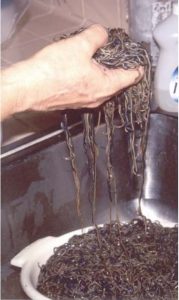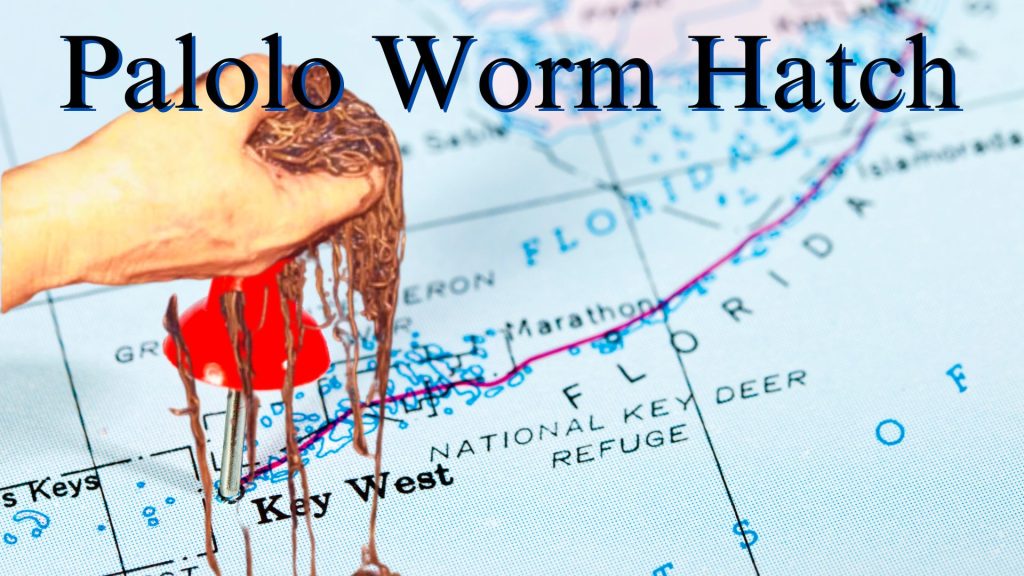Every year, the Florida Keys play host to an extraordinary event known as the Palolo Worm Hatch. It is a phenomenon that captivates both anglers and tarpon alike.

image attribution: Wikipedia
During this time, as the lowest tide of the full moon in May or June approaches, the tarpon’s behavior takes an unexpected turn. They become intoxicated by the presence of the Palolo worms, exhibiting heightened aggression and rolling in large numbers.
This intoxicating feast not only marks the tarpon’s breeding season but also presents a unique opportunity for fly anglers to test their skills in the waters of the Atlantic Ocean.
The Predictable Phenomenon: Annual Palolo Worm Hatch
The Palolo Worm hatch is a highly anticipated and predictable annual phenomenon in the Atlantic Ocean side of the Florida Keys. This natural event has both environmental and cultural significance.
From an environmental standpoint, the hatch serves as a vital food source for various marine species in the area. The worms, resembling red and white earthworms, provide a rich source of nutrients for the ecosystem. Additionally, the sudden influx of worms triggers a feeding frenzy among predatory fish, such as tarpon, further contributing to the overall biodiversity of the region.
Culturally, the Palolo Worm hatch has become an important event for fishing enthusiasts and tourists alike. It draws attention from around the world and offers a unique opportunity to witness the remarkable behavior of tarpon during this period. This natural spectacle has become deeply ingrained in the local culture and has even influenced the timing of fishing seasons in the Florida Keys.
Tarpon’s Unusual Behavior: Intoxication and Aggression
During the Palolo Worm hatch, fly anglers can witness the unusual behavior of tarpon as they become aggressive and roll in large numbers. This feeding frenzy is believed to be triggered by the intoxicating effect of the worms, which are known to be an aphrodisiac and catalyst for the tarpon’s breeding season.
The tarpon’s aggression and rolling behavior during the hatch is a spectacle to behold. This behavior is not only fascinating to observe, but it also has significant effects on tarpon reproduction. The increased feeding activity during the hatch allows tarpon to consume large amounts of food, providing them with the necessary energy for successful reproduction.
Additionally, the gathering of tarpon in large numbers during this time increases the chances of successful mating and fertilization. The Palolo Worm hatch, therefore, plays a crucial role in the reproductive success of tarpon.
Prime Fishing Spots for Fly Anglers
Fly anglers can find prime fishing spots on oceanside flats, along the edges of the flats, or in deep channels crowded with bait chunkers during the Palolo Worm hatch. Here are some tips for locating and approaching tarpon in these spots during the hatch:
-
Oceanside flats: Set up on these flats and wait for the fish to come by. Tarpon are known to gather in large numbers during the hatch, making this a great spot to target them.
-
Edges of the flats: Guides can take anglers to hunt for fish along the edges of the flats. This area provides a prime location for casting to tarpon as they cruise along the edges.
-
Deep channels: While productive, these spots are often crowded with bait chunkers. However, if you can find a less crowded area, targeting tarpon in deep channels can be very successful during the hatch.
-
Known tarpon holes: Bahia Honda Bridge, Seven-Mile Bridge, Channel 2, and Channel 5 are good options to consider. These locations have a reputation for attracting tarpon during the Palolo Worm hatch.
Timing and Factors Influencing the Palolo Worm Hatch
Factors such as ambient air temperature, water temperature, and humidity levels play a significant role in determining the timing of the Palolo Worm hatch in the Florida Keys. These environmental conditions influence the Palolo worm hatch timing, making it a complex and dynamic phenomenon.
The ambient air temperature affects the metabolism and development of the worms, while the water temperature directly impacts their hatching process. Humidity levels also play a crucial role, as they affect the moisture content in the substrate where the worms reside.
Additionally, the interplay between these factors and lunar cycles further affects the timing of the hatch. While the exact time of the hatch cannot be pinpointed, understanding these environmental factors can help predict the general timeframe.
Observing and studying these factors is essential for anglers and scientists alike, contributing to a better understanding of this fascinating natural event.
Identifying the Worms: Rag Worms Vs Palolo Worms
The rag worms commonly seen during the annual event in the Florida Keys are often mistaken for Palolo worms due to their similar appearance and behavior. However, there are distinct differences between the two species. Here are some key points to help identify the worms:
-
Rag worm behavior:
- Rag worms transform large portions of their bodies to become better swimmers.
- They have a more active and agile swimming style compared to Palolo worms.
-
Palolo worm anatomy:
- Palolo worms only have their posterior end break off and swim to the surface.
- They have a red and white coloration, resembling earthworms.
-
Appearance and behavior:
- Rag worms and Palolo worms look alike, with similar coloration and movement.
- Both species participate in synchronized mass spawning events.
-
Importance of accurate identification:
- Correctly identifying the worms is crucial for understanding the hatch and its ecological implications.
- Further research is needed to fully understand the behavior and biology of these fascinating organisms.

